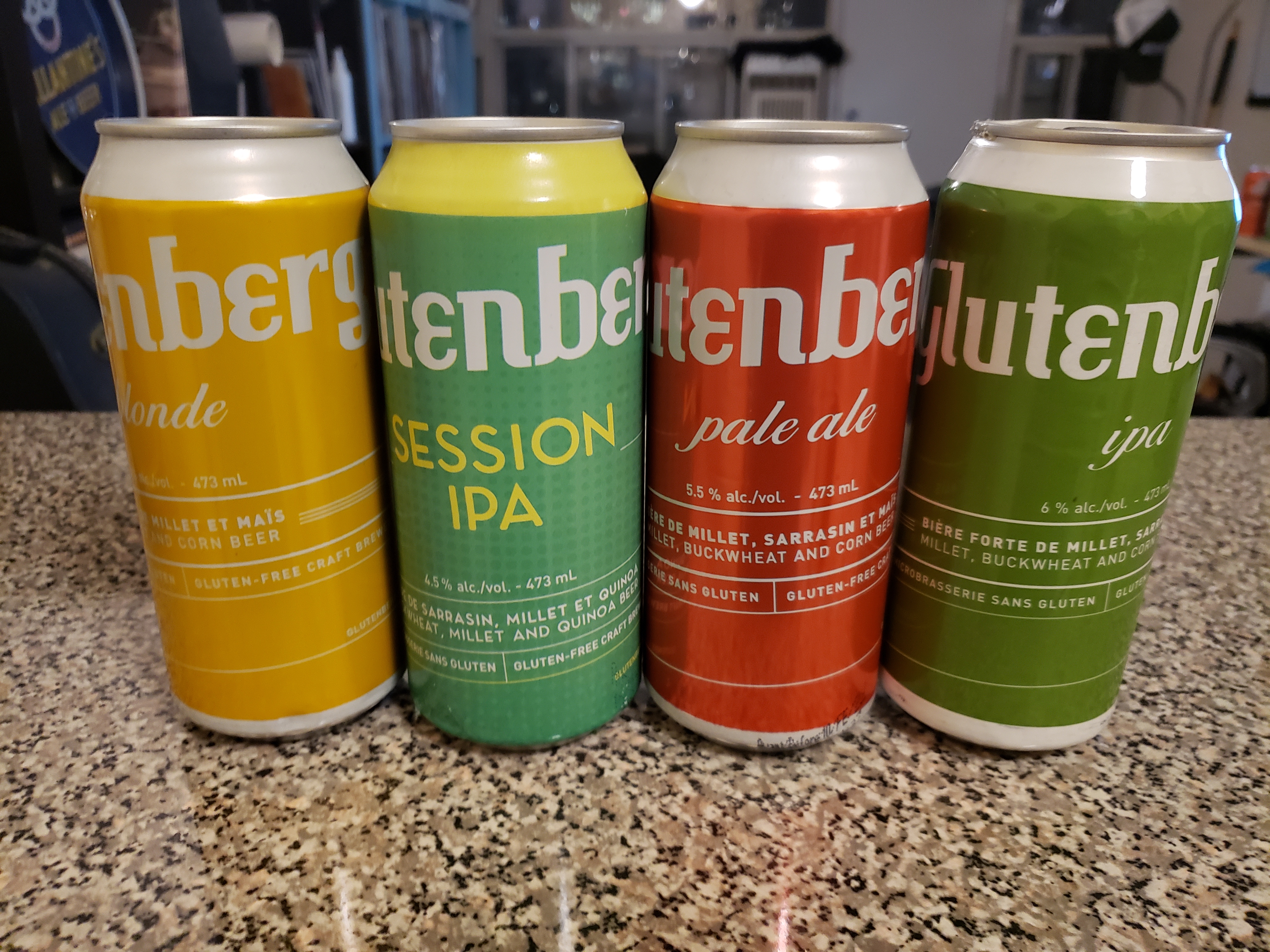
As we reach the end of the semester, I’m on the hook for marking papers. (Ed. Note: If you’d like to enroll someone in a beer class for Christmas, just follow the link) One of these papers is going to require a little extra effort. One student announced fairly early in the going that she had a small problem: she was seriously gluten intolerant.
This is something that crops up periodically, although not always in a pedagogical capacity. People will say, “I have celiac disease, what beer should I drink?”
My answer is typically cider. There are any number of really good ones, and there’s no protein to speak of. West Avenue and Revel are making some wonderful things. You’re never short of innovation there. I’ll explain about Chris and Tariq and how they are both slightly crazy. I’ll go on to explain that Thornbury and Spirit Tree are both very pleasant and affordable options.
“No,” they typically say, “I don’t like cider.”
Well, fair enough.
I invoke the dark art of Brewer’s Clarex and mention that Perth Brewery in Eastern Ontario makes some credible beers in various styles and they use Clarex to filter, which strips out gluten without really affecting the flavour profile. People sometimes look askance at that because they don’t market their beers that way. Something to do with liability, as I understand it.
Also fair enough.
Since the primary method of assessment for the course is an assignment in which you have to drink six to ten beers and tell me about them in great detail, there’s a problem. There aren’t that many gluten free beers on the market in Ontario.
I did what any sensible person would do. I reached out to the Glutenberg Craft Brewery in Montreal to see if I could get them to help.
Now, you can’t get all of their beer here, so in order to get enough beers for the assignment to work, they were going to have to ship them along. Two packages! One for the student, and one for me so I know what I’m marking. I can’t tell her if she’s right if I haven’t tried the beers. They were very nice about it as well. Quite understanding.
The fact is that I don’t know a huge amount about this genre. Let’s taste through these Glutenberg beers and see what we can learn.
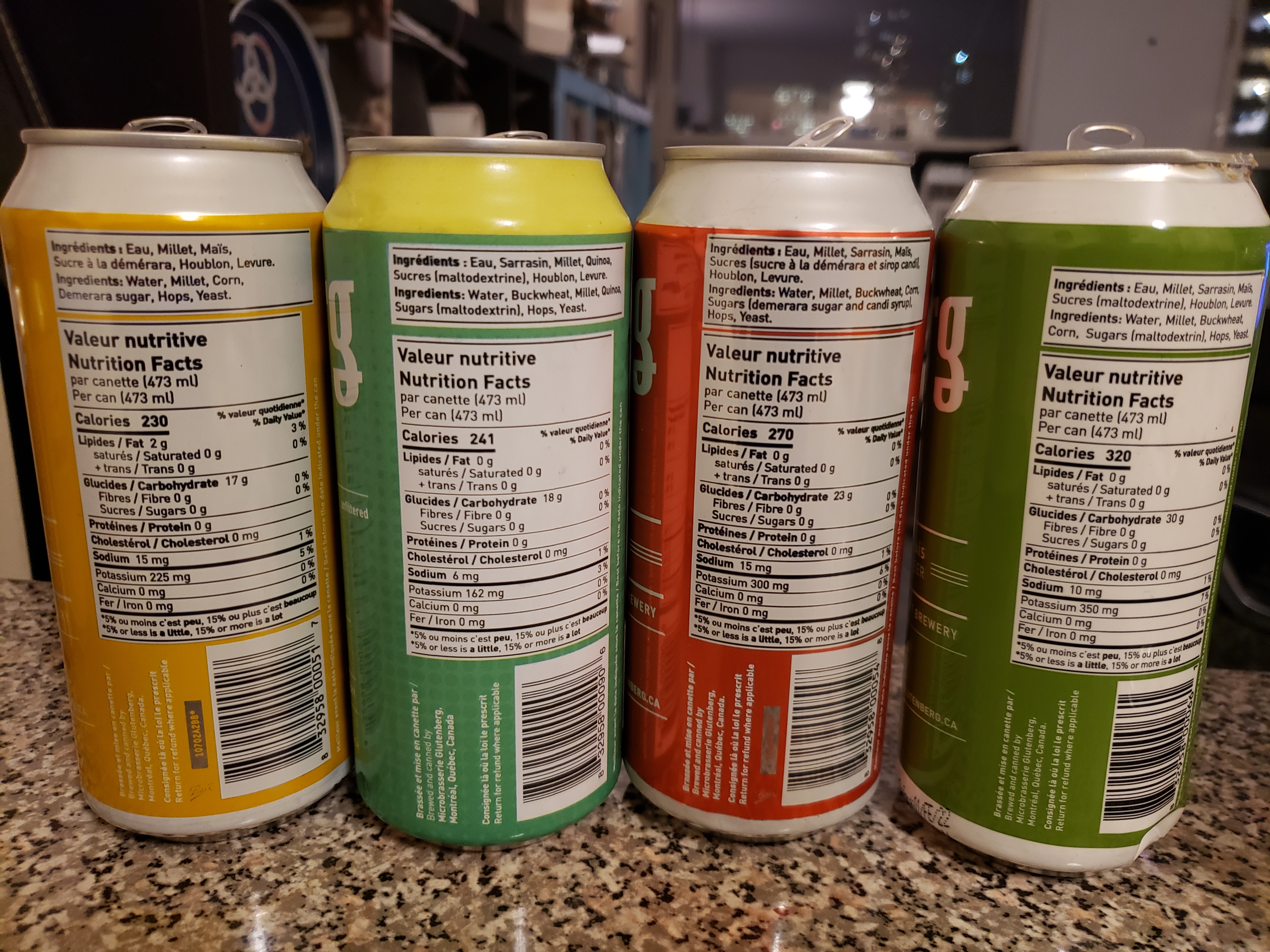
GLUTENBERG
There are some interesting foibles at play here. Since all of the ingredients are listed, the nature of the product requires stability in labelling. It must always be the same in order to ensure consistency from an allergen perspective. What this means is that not only are all of the ingredients listed on each can, but the caloric content is listed as well.
This raises questions about intent. Are people who drink glutenberg drinking them in quantity? Is someone sitting there with a six pack and getting through them over the course of an afternoon? How does the presence of the caloric content on the can affect that decision? As you can see, the quantity increases somewhat as you go along up the spectrum of alcoholic content. Would people drink as much beer if they did if they knew the four cans of IPA they drank contained 1200 calories?
The second thing I’m curious about is that the grain ingredients are listed in complete detail, but when it comes to hops they don’t list the varieties. It seems to me they’re missing a trick. In order to want to drink beer as a gluten intolerant person, you must be pretty interested in the ingredients. Since I don’t know what hops go in each beer, I’m going to be guessing.
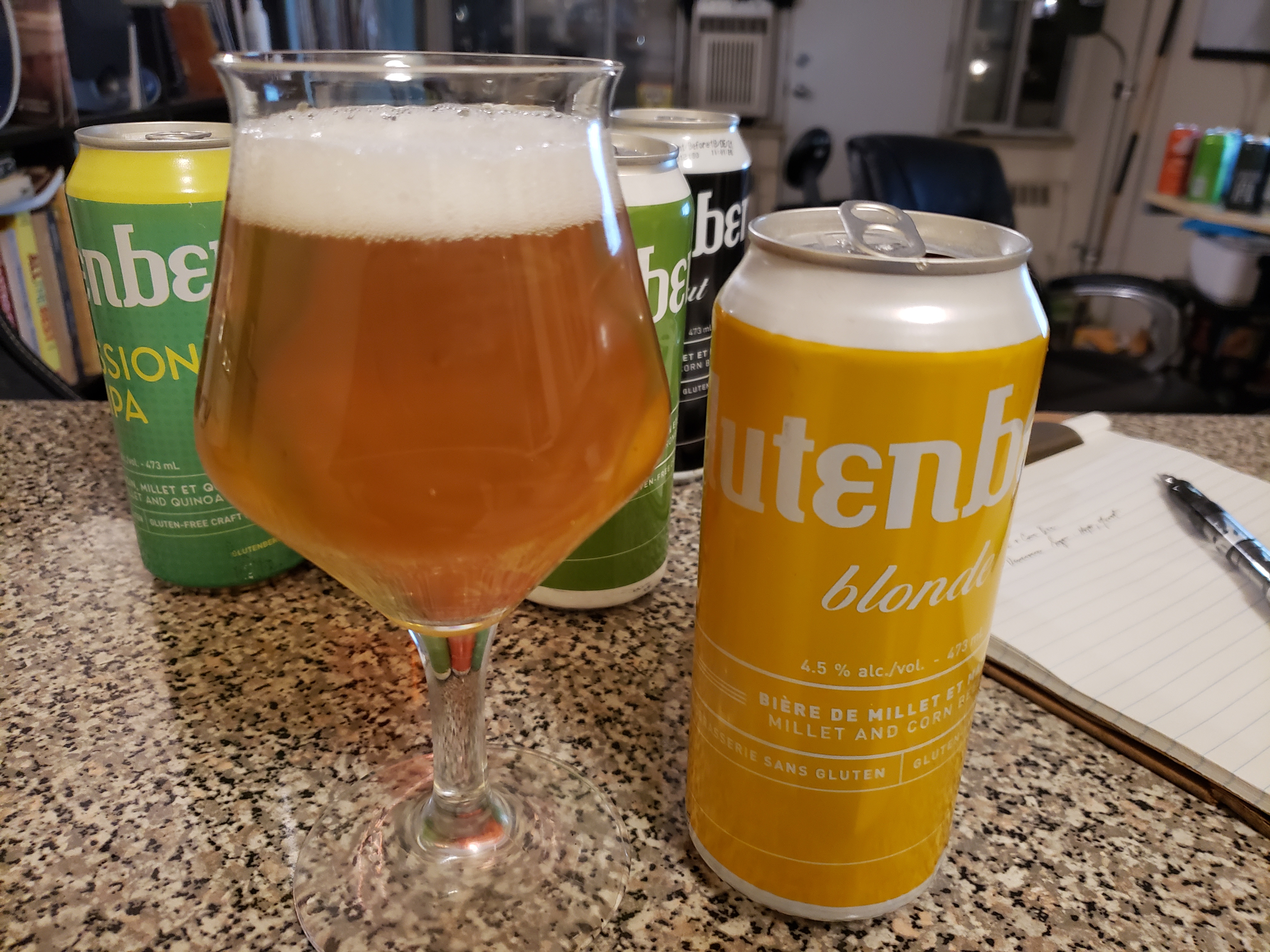
First things first, all of these beers are ales.
The Glutenberg Blonde is specifically made with millet and corn, but also includes some demerara sugar. Right off the bat, we’ve got a bright, pleasant lemon scent, and given the pepper that follows it, it could easily be saaz. There’s a little pear ester from the fermentation. The difference here is inevitably going to be in the grain, and I’ve written in the notes that there’s a dryness above the grain character in the aroma. The corn is lightly sweet, as it typically is, but there’s a small campfire whiff from somewhere that is not exactly smoke. It’s more like spice. There’s a dry, spicy character at the head of the swallow that is misplaced for hop bitterness so it must be the grain.
The connotation here is practically that of a farmhouse beer given the dryness of the body, so there’s the suggestion of saison, but without the significant phenolics or carbonation.
Let’s think about Millet. Millet is a cereal grain, but the majority of malted millet is apparently a variety called proso. It’s an annual crop in the same way that barley is, but the protein content is actually more comparable to wheat. It doesn’t really have amylase, so you still need to add enzymes in order to kick fermentation into full gear. There’s ostensibly a light nuttiness to it, but it folds into the light grain character so as not to be massively noticeable.
Corn is going to act predominantly as a form of bioavailable glucose once the enzymes kick in, probably without adding much flavour. There is flavour, but mostly that is going to fall under “sweet.”
The demerara is a lightly processed sugar which contains minerals and some natural molasses, but I’m not picking up a ton of that in the flavour profile, so it has to be a minor addition. All of these beers have some variety of sugar in them, so I’m forced to assume that there’s a textural role that they perform in supplying alcohol when they’re bioavailable and residual body when they aren’t.
That said, this is better than several basic blonde ales I’ve had this year. It’s simple, but the dryness on the palate is refreshing and the bright lemon character is really welcome. I’d happily drink this, gluten or no.
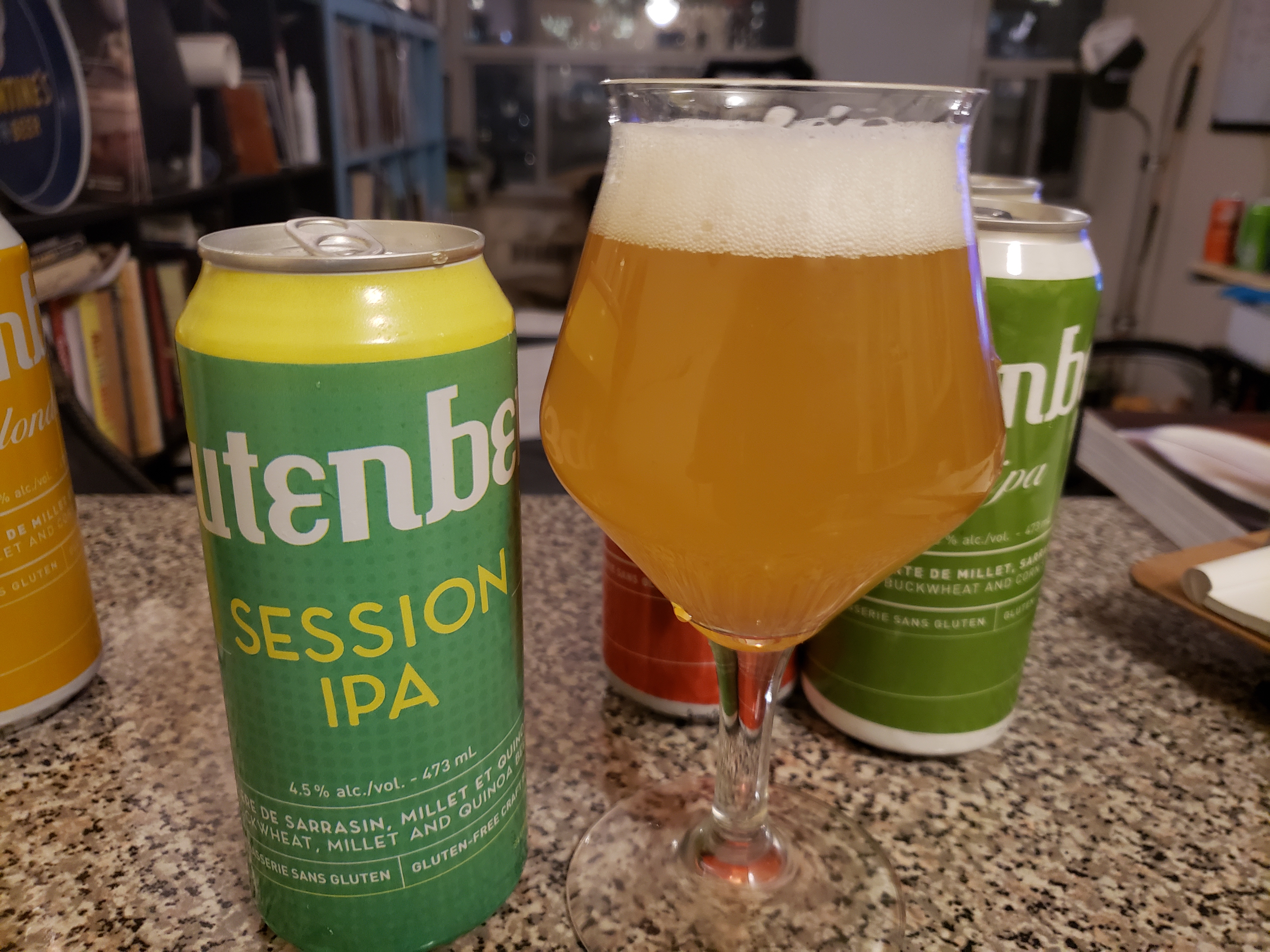
GLUTENBERG SESSION IPA
I said I was guessing about hops, and in this instance I’m guessing at citra and amarillo. This has slightly better head retention than the Blonde, and this is possibly due to the presence of Buckwheat and Quinoa.
Buckwheat is not really a grain. It’s sort of a pseudo cereal, but the seed pod is like the barley kernel in its structure, and it contains a similar amount of starch. There’s also amylase involved, meaning that the conversion in the mash is going to happen as normal. This possibly explains the presence of maltodextrin in the session IPA, which is going to be a textural addition. It’s a polysaccharide that you can digest pretty easily, but not yeast. You see this in some non-alcoholic beers. Without the alcohol you need texture, and without gluten that seems to hold true.
The flavour profile here has some commonalities with the Blonde. The hops come across as peach, pineapple, clementine, and lemon, but there’s a light, practically oat-like nuttiness that might be derived from the quinoa. I think the millet continues to produce that extremely light dryness on the palate, but it eventually folds into the hop profile on the finish.
It’s actually fairly close to Muskoka Detour. I envision it as a Session IPA from about 2015, and it’s interesting trying to discover what Glutenberg might be aiming for. If you assume that the audience is people who lost the ability to drink gluten rich beer, then nostalgia is maybe part of the appeal. A snapshot of time.
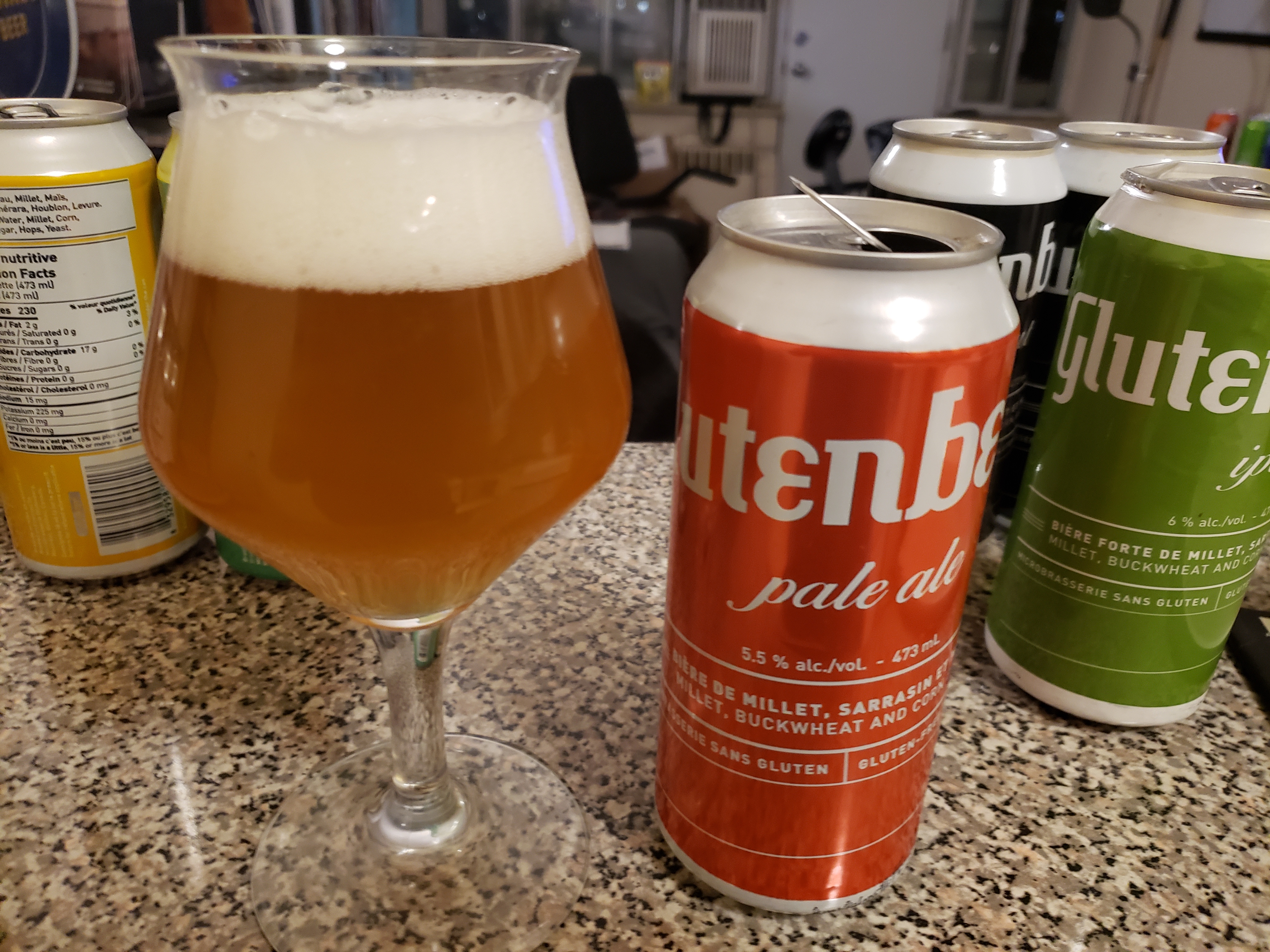
GLUTENBERG PALE ALE
With the components delineated, this gets easier. The Pale Ale contains demerara and candi sugar to supplement the millet, buckwheat, and corn. I’d guess the inspiration for this is sort of Mid 2000’s West Coast IPA, and the orange, grapefruit, pine, and pineapple character of the hops suggest that this might be Cascade, Centennial, and a little Simcoe. As it opens up, the pine character becomes dominant down to nearly camphor, there’s something nearly minty about it as it sits. The nutty sweetness and caramel become more prominent as well, and while this is only 5.5%, it does seem to have the profile of a larger beer in mind. This could easily get bumped to 7% without significantly changing the profile.
The peppery dryness on the finish seems to persist across the entire range, which narrows it down to yeast and millet.

This contains millet, buckwheat and corn, and at 6% is reminiscent of an early New England style IPA. The hops are tropical, with a little pineapple and mango. It’s not as citric as the Pale Ale or Session IPA, but I think that’s the style. The difficulty here is that the peppery dryness persists and interferes slightly with the pillowy NEIPA thing that they’re going for. That light pillowy texture is a little compromised by the house character.
That said, it’s still quite a good representation of a style that usually depends on oats for texture and body. In this case, there’s a little maltodextrin and the body doesn’t suffer as a result. I think there’s a lot that non-alc producers can learn here about textural backsweetening.
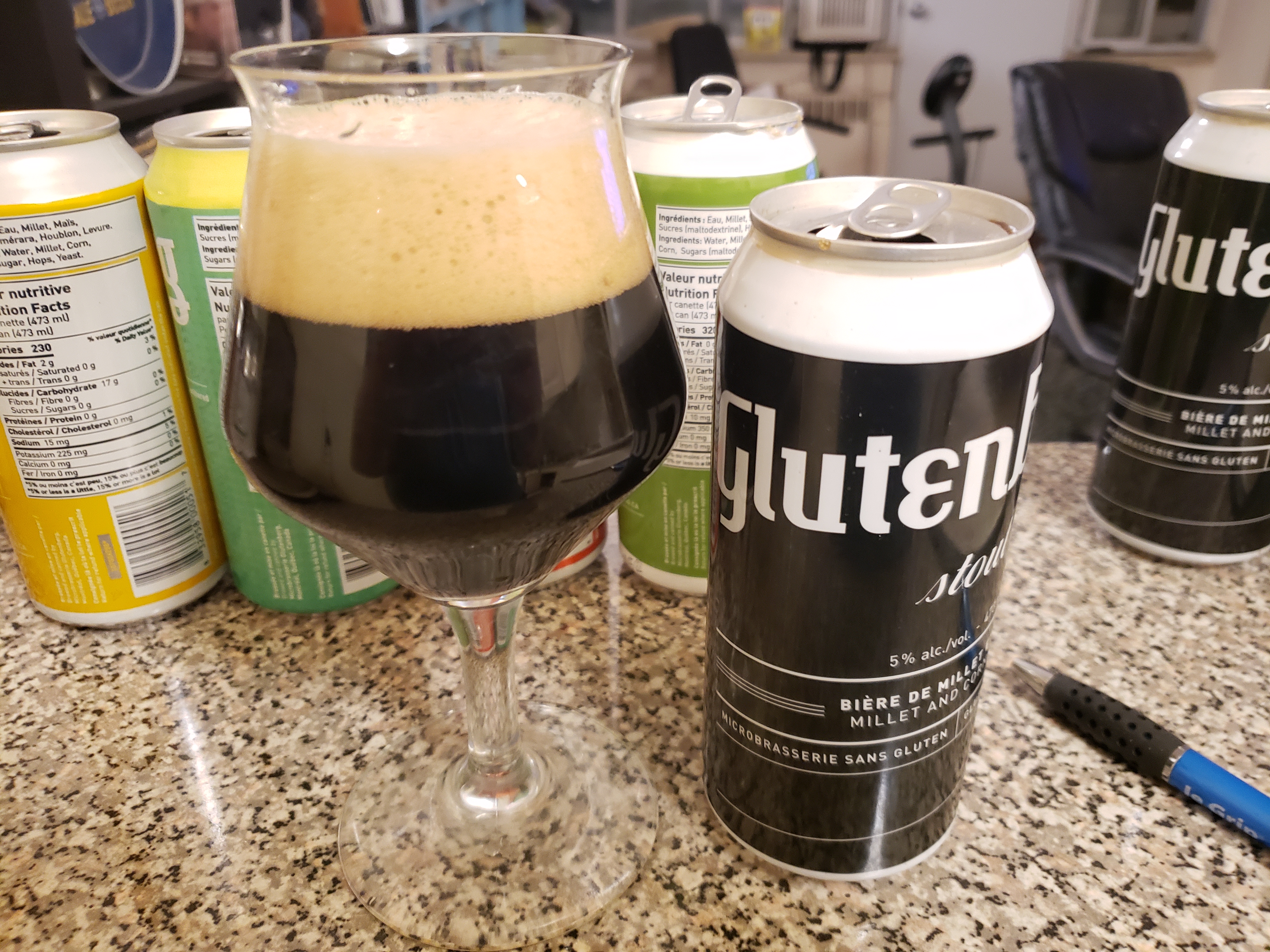
I wondered how they were going to get around roasted barley, and the answer was “easily.” Roasted Barley is essentially just this side of burnt when you take it out of the kiln, so pretty much any deeply roasted grain ought to emulate that. In this case they’ve gone with millet and corn as the base fermentables, and they’re deriving the roast from the coffee and cocoa nibs. Plus, the candi syrup is going to emulate a little treacle and dark fruit character in effect. There’s quite a pleasant plummy note.
It’s got a lot in common with a White Stout like Blood Brothers Guilty Remnant, now that I think about it. It’s just a question of copping flavours from places you might not expect. A shell game made a little bit easier by the insistence of brewers on making pastry stouts over the last several years. This one is available in the LCBO at the moment, and potentially worth your time even if you’re not gluten intolerant.
————————
Alternative fermentables are used all over the world and the millet and buckwheat, which tend to be from arid climates, are probably things we’re going to need to look into in the near future.
One thing this has certainly highlighted for me is how much we’ve become dependent on wheat and oats in the last half decade as the influence of New England IPAs has crept into other styles. I wonder whether that makes the Glutenberg products more accessible than they would have been six or seven years ago since haze and cloudiness are not issues in the general market anymore.
I really like that they’re not exactly trying to emulate the flavour profile of gluten rich beer, but rather making judgements that work with what’s possible while still creating flavourful beer that fits exactly within expectation based on labelling.
While this is not a sponsored post so much as it is a kindness on their behalf, I’d like to thank Glutenberg for making a concession to enable not only some learning on my behalf, but on the behalf of one of my students. It’s nice to have an answer to replace, “cider.” It’ll also be nice to be able to mark an assignment accurately.
Said student who was diagnosed with Celiac and a former lover of beer is very appreciative to Glutenberg for the opportunity to try all of these beers. Thank you to Jordan for arranging so I can learn the techniques outlined in the class.
Seems like quite the challenging adventure to create a gluten-free beer that is so sought after at retail. This brewery does pretty darn well in LCBO. A fantastic brewery who was once around with gluten-free options was Snowman brewing from Ontario they had a gluten free red ale that was just fantastic.
Snowman was good in terms of quality. In terms of approach, they dreamed a little too small. Custom malting in filing cabinets as I recall. Shame really. People really liked that quad they made.
A gluten-free quad… pretty ambitious -good for them. Having a gluten-free tap in the odd establishment helps with inclusion but it might also be revealing. Some people might be ‘slightly intolerant to gluten’ like others are to lactose and not even know it until they have a good drinking experience with a a good gluten-free beer.